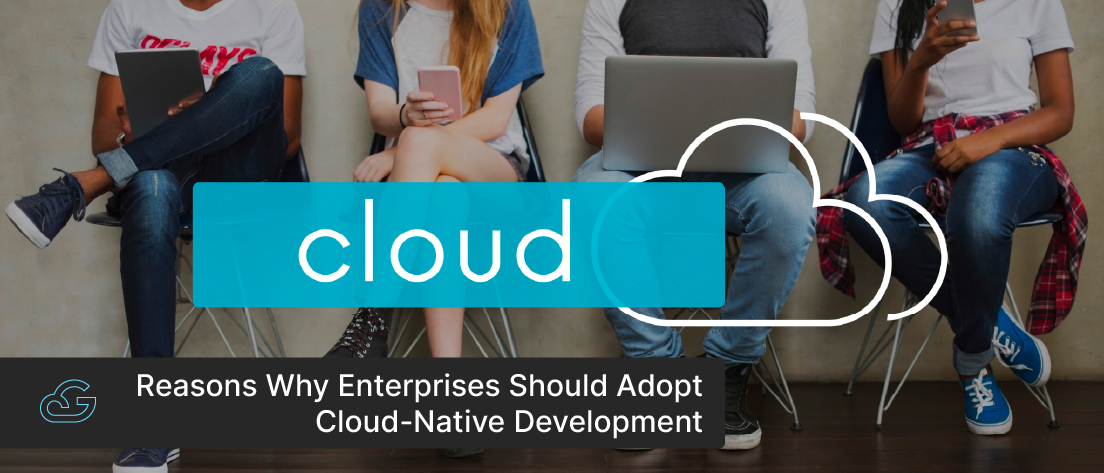Blogs / Cloud Native Development
Why Enterprises Should Adopt Cloud-Native Development Approach?
By
Sibin Vincent
Posted: October 12, 2023
• 4 Min Read
Are you planning to move your business operations to the cloud or actively evaluating various cloud adoption models to get started? Then it is important to understand what cloud-native development is and what are its advantages.
Cloud-native development is an approach to building and deploying applications that take full advantage of the cloud computing model. With this approach, you can design, develop and optimize applications specifically to run on cloud infrastructure, using cloud-native technologies such as microservices architecture and containerization.
In recent years, cloud-native development has gained popularity due to its ability to help organizations build and deploy applications faster, more reliably, and at scale. Gartner reports that “by 2025, cloud-native platforms will serve as the foundation for more than 95% of new digital initiatives — up from less than 40% in 2021”. Sounds great, right? Now think about how your business can gain from this approach and how it helps you make an informed decision that supports your business goals.
Why Enterprises Should Adopt Cloud-Native Development Approach?
- Automated Development Environment
- Quick Application Scalability
- Resilience and Reliability
- Cost Efficiency Achieved with Flexibility
- Built-in Security and Compliance
- Reusability with Serverless Platforms
- Avoid Vendor Lock-ins
- Enhance Customer Experience
Cloud-native development encompasses agile methodology practices and DevOps automation to increase the efficiency of the application development process throughout the cycle. By focusing on collaboration and continuous integration and delivery (CI/CD) processes, your development and operations team can work and collaborate more to quickly deliver high-quality applications.
Cloud-native applications are designed to run on cloud infrastructure, which is inherently scalable. This means that your application can be built using a microservices architecture, which makes the app broken down into smaller, independent services that can be developed, deployed, and scaled independently. As a result, your businesses would be able to respond quickly to changing market conditions and customer needs and develop new features without the need for significant infrastructure investment.
For example, you can scale your application horizontally, rather than vertically. Instead of requiring expensive upgrades to processors, storage, or memory on existing servers, the applications can be scaled out by adding more servers to the network. This makes it much more cost-effective to handle large amounts of traffic or data and introduce real-time improvements to optimize your app's performance.
With cloud-native applications, redundancy, and fault tolerance are built into the architecture from the ground up. This helps you to design and develop applications that are highly available, with automatic failover and self-healing capabilities with minimal downtime. This is implemented by utilizing Microservices technology that divides your entire application into smaller, independent components, each functioning as a service, hence tracing the origin of the issue is much simpler.
If any failure occurs, the affected service can be isolated, and the issue can be fixed at the source without any server downtime. That means even if one component of the application fails, the rest of the application can continue to function without interruption. This not only improves user experience, but also reduces the risk of revenue loss, data breaches, and other adverse effects of downtime.
Cloud-native development can also be more cost-efficient than traditional application development. Cloud-native applications run independently of operating systems or on-premises infrastructure, allowing you to switch your app to cloud platforms such as public, private, or hybrid cloud. This means that you can select the cloud provider that best suits your needs, and easily move applications and data to a different provider if necessary. This can go a long way to save operational costs and take full advantage of the latest cloud technologies and services they provide.
In addition, cloud-native solutions allow you to utilize the pay-as-you-go pricing model means that you can easily scale the resources up or down to meet the changing demands, without having to commit to long-term contracts or over-provisioning resources. This can result in significant cost savings over time, as you only pay for what they need when they need it.
With cloud-native applications, security is built into the application from the root level, with encryption, access controls, and other security features baked into the architecture. Additionally, cloud-native applications can be easily updated and patched to address security vulnerabilities, ensuring that businesses are always protected against the latest threats. This approach, known as "security by design," helps you to ensure that security is an integral part of the application and not an afterthought.
Moreover, cloud-native platforms make it easier to implement legal requirements, such as data protection regulations like GDPR or CCPA. Compliance can be built directly into the application, ensuring that data is handled in a secure and compliant manner.
Cloud-native applications can easily leverage serverless platforms to upload specific portions of code, which can perform their designated functions in isolation. This approach enables you to reuse code segments while creating new projects using the same codebase. Furthermore, serverless platforms provide a cost-effective and scalable solution for running cloud-native applications. You need to pay only for the actual execution time of their code, rather than having to provision and manage costly infrastructure.
Traditional application development often requires sticking to the same cloud vendor due to the time and effort invested, which can lead to poor quality services and pricing plans beyond the budget. However, cloud-native applications offer the flexibility to use services from multiple cloud providers, reducing vendor lock-in.
In contrast, cloud-native applications are designed to be decentralized, making it possible to choose a cloud vendor who assures performance, security, and maintenance. If a vendor fails to meet expectations, it is possible to switch to a better cloud pricing and benefits plan without having to start from scratch.
Cloud-native applications can also enable you to adopt a mobile-first approach to application development, which is becoming increasingly important as more and more customers use mobile devices to interact with businesses. By ensuring a seamless connection between applications, continuous feedback loops, and deployment, cloud-native solutions can help your business to iterate quickly and constantly improve the customer experience.
Final Words
While not all benefits of the cloud-native field may apply to your organization, carefully selecting the ones that do can pay off in the long run. By utilizing the expertise of a cloud-native development service provider, you can customize a cloud-native application or infrastructure based on the needs of your industry and target audience. Whether you're new to the cloud space or need help migrating to the cloud, Gsoft’s cloud computing experts can assess, evaluate, and guide you in building a cloud-native application. Contact us today to learn more.


Get Know More About Our Services and Products
Reach to us if you have any queries on any of our products or Services.











